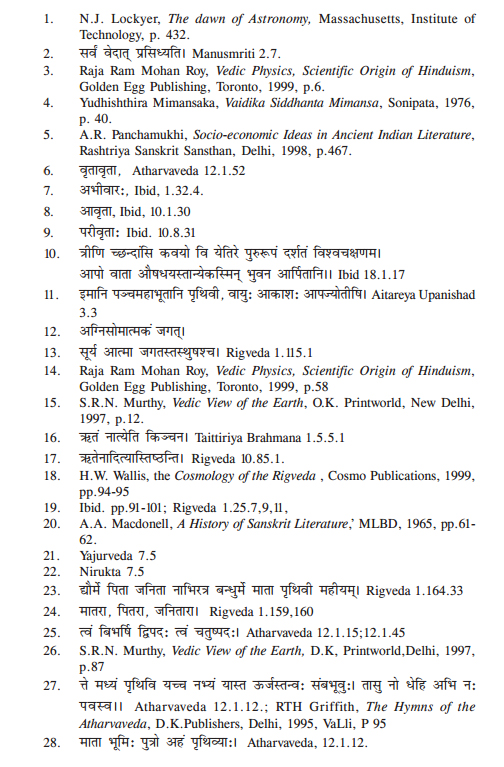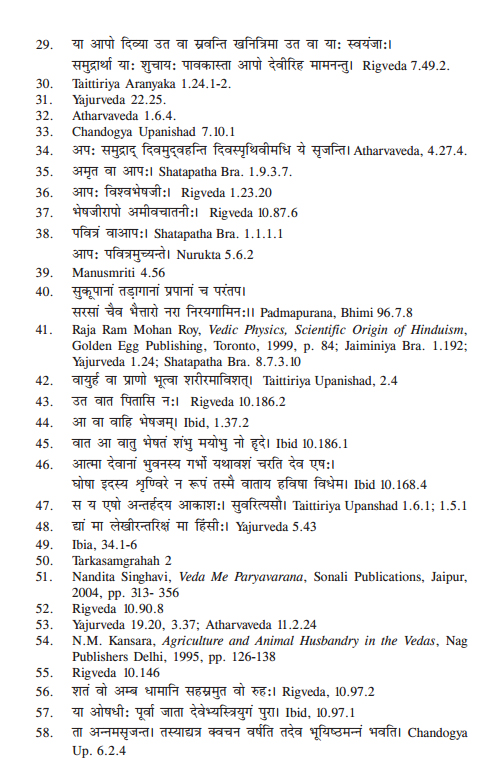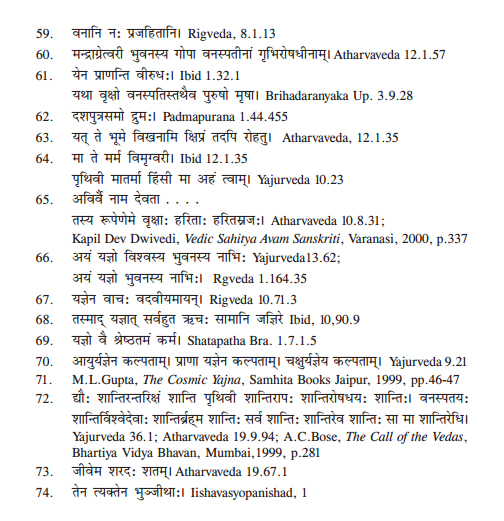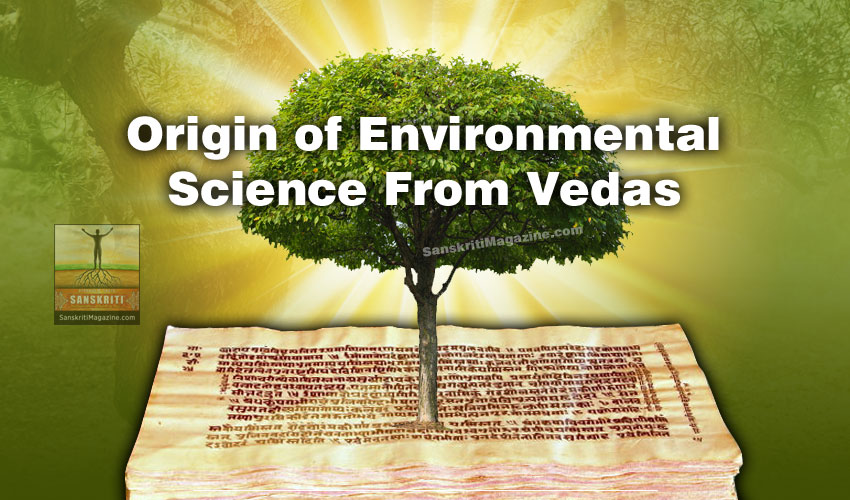The Vedas are the first texts in the library of mankind. They are universally acknowledged to be the most precious Indian Heritage. The antiquity to the Vedic civilization is debated to a great extent but indeed there is no civilization known to humanity with such antiquity as Vedic Aryan Civilization. The so-called Aryans would have originated in the Aryavarta. N. J. Lockyer has declared: “The Vedas, in fact, is the oldest book in which we can study the first beginnings of our language and of everything which is embodied in all the languages under the sun.” (1)
 The Vedas deal with knowledge, the knowledge of all sorts. They cover knowledge both physical and spiritual. They are source of all knowledge according to Manusmriti. (2) Especially the Vedic views revolve around the concept of nature and life. The visions of the beauty of life and nature in the Vedas are extremely rich in poetic value. Perhaps nowhere else in the world has the glory of dawn and sun-rise and the silence and sweetness of nature, received such rich and at the same time such pure expression. The symbolical pictures projected there remain close to life and nature. The most authoritative among the four Vedas is called the Rigveda. Each Vedic verse has one or more sages (Rishis) and deities (Devatas) associated with it. Generally, Rishis are supposed to be the recipient of knowledge revealed in the verses and Devatas are supposed to be the gods in whose praise verses are revealed.
The Vedas deal with knowledge, the knowledge of all sorts. They cover knowledge both physical and spiritual. They are source of all knowledge according to Manusmriti. (2) Especially the Vedic views revolve around the concept of nature and life. The visions of the beauty of life and nature in the Vedas are extremely rich in poetic value. Perhaps nowhere else in the world has the glory of dawn and sun-rise and the silence and sweetness of nature, received such rich and at the same time such pure expression. The symbolical pictures projected there remain close to life and nature. The most authoritative among the four Vedas is called the Rigveda. Each Vedic verse has one or more sages (Rishis) and deities (Devatas) associated with it. Generally, Rishis are supposed to be the recipient of knowledge revealed in the verses and Devatas are supposed to be the gods in whose praise verses are revealed.
The oldest and simplest form of Nature-worship finds expression in Vedic texts. Many scholars have come to the conclusion that the Vedas are primarily concerned with cosmology, however, they are not in a position to show that Vedic cosmology has the solutions to the most difficult problems of modern cosmology. (3) Some say, like dramas are played to remember history, the process of various shrauta yajnas describes the science of Cosmology. (4)
The Vedic hymns are full of statement, ideas and unusual images which contain truths of all sciences. Here, knowledge is couched in symbolic language and unless the symbols are decoded, the real purport of the mantras cannot be understood. The only point is that Vedas need to be studied and interpreted, not in a pedantic manner, but in their proper perspective and in relevant context. The tripartite model of knowledge at the basis of the hymns helps in their understanding. Generally indication of most of the principles is there in their earliest from. Often expressions of ideas are enveloped with the shade of symbolism. The approach of Vedic seers is truly comprehensive. They do not visualize in parts. They do not elaborate subjects as is done in current education. But at the same time, grandeur and brevity of the Vedas are not found in the disciplines of modern science. The Vedas and disciplines of modern science are rather complementary and not contradictory. If modern science is seen or read through Vedic eyes, the students will be much benefited. Students of science may search the earliest of the ideas about any discipline in the Vedic literature.
 In recent days, environmental science and ecology are disciplines of modern science under which study of environment and its constituents is done with minute details. As Science, they are established in 20th century, but their origin can be seen long back in the Vedic and ancient Sanskrit literature. The concepts of environment differ from age to age, since it depends upon the condition, prevalent at that particular time. In this paper, an effort is made to find out the awareness of ancient Indian people about the environment. As Sanskrit literature is so wide we refer here mainly to Vedic texts, particularly the Vedic Samhitas.
In recent days, environmental science and ecology are disciplines of modern science under which study of environment and its constituents is done with minute details. As Science, they are established in 20th century, but their origin can be seen long back in the Vedic and ancient Sanskrit literature. The concepts of environment differ from age to age, since it depends upon the condition, prevalent at that particular time. In this paper, an effort is made to find out the awareness of ancient Indian people about the environment. As Sanskrit literature is so wide we refer here mainly to Vedic texts, particularly the Vedic Samhitas.
The Environment (Protection) Act, 1986 defines the environment as follows: ‘Environment includes water air and land and the inter-relationship which exists among and between water, air and land and human beings, other living creatures, plants, micro organisms and property.(5) From the above definition, it can be briefly said that environment consists of two components namely biotic (living organisms) and abiotic (non-living materials) factors. The living organisms can be grouped into three types – those living mainly on land, in water and in air. The non-living materials of the environment are land, air, water, property etc.
In modern Sanskrit, the word Paryavarana is used for environment, meaning which encircles us, which is all around in our surroundings. But in the Atharvaveda words equivalent to this sense are used; such as Vritavrita, (6) Abhivarah, (7) Avritah, (8) Parivrita (9) etc. Vedic view on environment is well-defined in one verse of the Atharvaveda where three coverings of our surroundings are referred as Chandamsi: Wise utilize three elements variously which are varied, visible and full of qualities. These are water, air and plants or herbs. They exist in the world from the very beginning. They are called as Chandansi meaning “coverings available everywhere.”(10) It proves the knowledge of Vedic seers about the basic elements of environment.
According to one indigenous theory established in the Upanishads, the universe consists of five basic elements – viz.,1. Earth or land, 2. water, 3. light or lustre, 4. air, and 5. ether. (11) The nature has maintained a status of balance between and among these constituents or elements and living creatures. A disturbance in percentage of any constituent of the environment beyond certain limits disturbs the natural balance and any change in the natural balance causes lots of problems to the living creatures in the universe. Different constituents of the environment exist with set relationships with one another. The relation of human being with environment is very natural as he cannot live without it. From the very beginning of creation he wants to know about it for self protection and benefit.
1. VEDIC APPROACH TO ENVIRONMENT
The Vedic Aryans were children of nature. They studied nature’s drama very minutely. Sand-storm and cyclone, intense lightening, terrific thunderclaps, the heavy rush of rain in monsoon, the swift flood in the stream that comes down from the hills, the scorching heat of the sun, the cracking red flames of the fire, all witness to power beyond man’s power. The Vedic sages felt the greatness of these forces. They adored these activities. They appreciated these forces. They worshiped and prayed them due to regard, surprise and fear. They realized instinctively that action, movement, creation, change and destruction in nature are the results of forces beyond men’s control. And thus they attributed divinity to nature.
(1) Divinity to Nature:
 Rigvedic hymns could be divided into many parts, but their main part belongs to Natural hymns, the hymns related with natural forces. Yet Vedic gods are explained in different ways by the scholars of India and West, but speaking generally, the hymns addressed to deities (Devata) are under the influence of the most impressive phenomenon of nature and its aspects. The word Devata means divine, dignity which is bright, strong, donor, and powerful. In these hymns we find prayers for certain natural elements such as air, water, earth, sun, rain, dawn etc. The glorious brightness of the sun, the blaze of the sacrificial fire, the sweep of the rain-storm across the skies, the recurrence of the dawn, the steady currents of the winds, the violence of the tropical storm and other such natural energies, fundamental activities or aspects are glorified and personified as divinities (Devata). The interaction with nature resulted in appreciation and prayer but, indeed, after a good deal of observation. Attributes assigned to deities fit in their natural forms and activities, as Soma is green, fire is bright, air is fast moving and sun is dispenser of darkness. The characteristics of these forces described in the verses prove that Vedic seers were masters of natural science.
Rigvedic hymns could be divided into many parts, but their main part belongs to Natural hymns, the hymns related with natural forces. Yet Vedic gods are explained in different ways by the scholars of India and West, but speaking generally, the hymns addressed to deities (Devata) are under the influence of the most impressive phenomenon of nature and its aspects. The word Devata means divine, dignity which is bright, strong, donor, and powerful. In these hymns we find prayers for certain natural elements such as air, water, earth, sun, rain, dawn etc. The glorious brightness of the sun, the blaze of the sacrificial fire, the sweep of the rain-storm across the skies, the recurrence of the dawn, the steady currents of the winds, the violence of the tropical storm and other such natural energies, fundamental activities or aspects are glorified and personified as divinities (Devata). The interaction with nature resulted in appreciation and prayer but, indeed, after a good deal of observation. Attributes assigned to deities fit in their natural forms and activities, as Soma is green, fire is bright, air is fast moving and sun is dispenser of darkness. The characteristics of these forces described in the verses prove that Vedic seers were masters of natural science.
In Vedic view, this world consists of Agni i.e., fire or heat and Soma i.e. water. (12) Sun (Surya) is the soul of all which is moving and also of which is not moving.13 Indra is most powerful god who kills Vritra, the symbol of cloud to free waters. Vritra means one who covers and is derived from the root vri, to cover. R.R.M. Roy opines that the main force of expansion in the Vedic cosmology is Indra, and his chief adversary, the main force of contraction, is Vritra.(14) Maruts are Indra’s associates. Vedic seers pray boldly to these natural forces and aspects for bestowing plenty and prosperity on them. Aditi is praised as Devamata, the mother of all natural energies and she symbolizes the Nature.
A famous geologist S.R.N. Murthy has written on the earth sciences in the Vedas. He has somehow a different opinion about Vedic gods and hence states, ‘the natural geological aspects have been described as Indra, Agni, Vayu, Varun, Usas etc. (15)
(2) Cosmic Order ‘Rita’ and Varuna:
In the Vedas, the order of the Universe is called ‘Rita.’ Rita reduces chaos to cosmos, and gives order and integration to matter. It also gives symmetry and harmony in the environment. Hence the conception of Rita has an aesthetic content too; it implies splendour and beauty. It is for this reason that the Vedic gods, upholding Rita, are all lawful, and beautiful and good. Their beauty is a significance attribute.
Rita is defined variously by scholars in different Vedic contexts, but in general sense it has been elaborated as great ‘cosmic order’ which is the cause of all motion and existence, and keeps world in order. No one can ignore it,(16) even gods are abided by the ‘Rita’ and they are born of Rita. It is controlling and sustaining power. It sustains sun in the sky.(17) Rita as Universal Law governs everything in the cosmos. The whole of the manifested universe is working under Rita. S.R.N. Murthy assumes it as a law of gravitation in simple form. According to H.W.Wallis, “The principle of the order of the world, of the regularity of cosmic phenomena, was conceived by the Rishis to have existed as a principle before the manifestation of any phenomena. The phenomena of the world are shifting and changeable, but the principle regulating the periodical recurrence of phenomena is constant; fresh phenomena are continually reproduced, but the principle of order remains the same; the principle, therefore, existed already when the earliest phenomena appeared.” (18)
In the Vedas, Varuna is depicted as the Lord of Rita, the universal natural order. He is sovereign god, great king, law-maker and ruler of cosmos and even of the gods. Basically, he is regarded as the Lord of water and ocean but chiefly he controls and keeps the world in order. From his throne on high he looks down upon all that happens in the world, and into the heart of man.(19) “By the law of Varuna heaven and earth are held apart. He made the golden swing, the sun to shine in heaven. He has made wide path for the sun. By his ordinances the moon shining brightly moves at night, and the stars placed up on high are seen at night but disappear by day. He causes the rivers to flow. As a moral governor Varuna stands far above any other deity. (20) Thus, the concept of Varuna represents the consciousness of Vedic seers in respect to controlling and balancing the natural forces in environment.
(3) Division of Universe:
Vedic seers have a great vision about universe. The universe is made on scientific principles, and that’s why it is well measured. The universe consists of three intertwined webs, Prithivi, Antariksha and Dyau. Vedic scientists divided even the length in three calling them upper, medium and lower. The tripartite division of the universe into three regions – Prithivi, the earth, Antariksha, the aerial or intermediate region which is between heaven and earth, and Dyau, the heaven or sky is very well established in the Vedic literature. Prithavi can be given a scientific name ‘observer space.’ It is our space, the space in which we live and die, whatever we can see and observe. From one end of the universe to the other end is the expanse of Prithivi, and that is what the name Prithivi means: the broad and extended one. Dyau can be termed ‘Light space’ because light propagates in this space. Antariksha can be termed as ‘Intermediate space’ as this space exists in between observer space and light space. A verse from the Yajurveda states that the division of universe was done on a subtle level, and not on gross level.(21) The Vedic sages had the capability of looking at such a subtle level, which is beyond the reaches of modern science. Here; in reference to environmental study, we regard the division of the universe as the most important concept of the Vedas.
Though a large number of gods are described in the hymns, and it is very difficult to arrange them in different classes, but Yaska in his Nirukta talks about three Gods: Agni in earth, Vayu or Indra in atmosphere and Sun in heaven. Each one of them is known by various names depending on the different actions performed.(22) These three gods are three major forms of energy, fire on earth, air in intermediate space and light in upper region. Other energies of those regions are related to or under them. So generally gods are classified in three groups called upper, middle and lower, and, therefore, provide a system to study atmosphere and its all aspects. Regarding global harmony, Vedic seers always pray for the welfare of all creatures and all regions.
2. CONCEPT OF THE EARTH ‘PRITHVI’
The concept of the form of the earth in the Rig-veda is most fascinating. It is mostly addressed along with the heaven into a dual conception (Rodasi, Dyavaprithivi). There is one small hymn addressed to Prithivi, while there are six hymns addressed to Dyavaprithivi. Prithivi is considered the mother and Dyau is considered the father in the Vedas, and they form a pair together. One of the most beautiful verse of the Rig-veda says, ‘Heaven is my father, brother atmosphere is my navel, and the great earth is my mother.’(23) Heaven and earth are parents: Matara, Pitara, Janitara (24) in union while separately called as father and mother. They sustain all creatures. They are parents of all gods. They are great (Mahi) and widespread. Earth is described as a goddess in Rig-veda.
In the Atharvaveda, the earth is described in one hymn of 63 verses. This famous hymn called as Bhumisukta or Prithivisukta indicates the environmental consciousness of Vedic seers. The seers appear to have advanced understanding of the earth through this hymn. She is called Vasudha for containing all wealth, Hiranyavaksha for having gold bosom and Jagato Niveshani for being abode of whole world. She is not for the different races of men alone but for other creatures also. (25) She is called Visvambhara because she is representative of the universe. She is the only planet directly available for the study of the universe and to realize the underlying truth. This is wide earth which supports varieties of herbs, oceans, rivers, mountains, hills etc. She has at places different colours as dark, tawny, white. She is raised at some place and lowered at some places. The earth is fully responsible for our food and prosperity. She is praised for her strength. She is served day and night by rivers and protected by sky. The immortal heart of earth is in the highest firmament (Vyoma). Her heart is sun. “She is one enveloped by the sky or space and causing the force of gravitation. She is described as holding Agni. It means she is described as the geothermal field. She is also described as holding Indra i.e., the geomagnetic field.
The earth is described then as being present in the middle of the oceans (sedimentary rocks) and as one having magical movements.” (26) The hymn talks about different energies which are generated from the form of the earth. “O Prithivi! thy centre, thy navel, all forces that have issued from thy body- Set us amid those forces; breathe upon us.’ (27) Thus, the earth holds almost all the secrets of nature, which will help us in understanding the universe. She is invested with divinity and respected as mother – “The earth is my mother and I am Her son.” (28) The geographical demarcations on this earth have been made by men and not by nature.
3. CONCEPT OF WATER ‘APAH’
Water is essential to all forms of life. According to Rig-veda the water as a part of human environment occurs in five forms:
- Rain water (Divyah)
- Natural spring (Sravanti)
- Wells and canals (Khanitrimah)
- Lakes (Svayamjah)
- Rivers (Samudrarthah) (29)
There are some other classifications also in the Taittiriya Aranyaka, (30) Yajurveda (31) and Atharvaveda (32) as drinking water, medicinal water, stable water etc. Chandogya Upanishad describes about qualities of water – ‘The water is the source of joy and for living a healthy life. It is the immediate cause of all organic beings such as vegetations, insects, worms, birds, animals, men etc. Even the mountains, the earth, the atmosphere and heavenly bodies are water concretized.’ (33) The cycle of water is described. From ocean waters reach to sky and from sky come back to earth. (34) Rainwaters are glorified. The rain-cloud is depicted as Parjanya god.
The fight between Indra and Vritra is a celebrated story from the Rig-veda. It is explained in many ways. According to one view it is a fight for waters. Indra is called Apsu-jit or conquering the waters, while Vritra is encompassing them. Vritra holds the rain and covers waters and thus being faulty is killed by Indra through his weapon called Vajra i.e., thunderbolt. The Indra-Vritra fight represents natural phenomenon going on in the aerial space. By the efforts of Indra all the seven rivers flow. The flow of water should not be stopped and that is desired by humanity. The significance of water for life was well-known to Vedic seers. They mention -Waters are nectars.(35) Waters are source of all plants and giver of good health. (36) Waters destroy diseases of all sorts. (37) Waters are for purification.38 It seems that later developed cultural tradition of pilgrimage on the river-banks is based on the theory of purification from water. The ancient Indians knowing water as a vital element for life, were very particular to maintain it pure and free from any kind of pollution. The Manusmriti stresses on many instances to keep water clean. (39) The Padma Purana condemns water pollution forcefully saying, ‘the person who pollutes waters of ponds, wells or lakes goes to hell.’ (40)
4. CONCEPT OF AIR ‘VAYU ’
The observer space is the abode of matter particles, light space is the abode of energy and the intermediate space ‘Antariksha’ is the abode of field. The principal deity of Antariksha is Vayu. Jaiminiya Brahmana quotes,’ Vayu brightens in Antariksha.’ Field is another form of energy and, therefore, Yajurveda says,’ Vayu has penetrating brightness.’ The meaning of Vayu is made clear in Shatapatha Brahmana in the following Mantra, ‘Sun and rest of universe is woven in string. What is that string, that is Vayu.’ This verse clearly shows that here Vayu cannot mean air alone. (41)
Apparent meaning of Vayu is air. The Vedic seers knew the importance of air for life. They understood all about air in the atmosphere and also about the air inside the body. The Taittiriya Upanishad throws light on five types of wind inside the body: Prana, Vrana, Apana, Udana and Samano Air resides in the body as life. (42) Concept and significance of air is highlighted in Vedic verses. Rigveda mentions – ‘O Air! You are our father, the protector.’ (43) Air has medicinal values44 ‘Let wind blow in the form of medicine and bring me welfare and happiness.’45 Medicated air is the international physician that annihilates pollution and imparts health and hilarity, life and liveliness to people of the world. Hilly areas are full of medicated air consisted of herbal elements. Another verse describes characteristics of air – ‘The air is the soul of all deities. It exists in all as life-breath. It can move everywhere. We cannot see it. Only one can hear its sound. We pray to air God. (46) Ancient Indians, therefore, emphasized that the unpolluted, pure air is source of good health, happiness and long life. Vayu god is prayed to blow with its medicinal qualities.
5. CONCEPT OF ETHER ‘AKASHA’
Modern environmentalists discuss sound or noise pollution. There is a relation between ether and sound. The sound waves move in sky at various frequencies. Scientist could see the sky which exists only in the vicinity of earth, but Taittirya Upanishad throws light on two types of ether i.e: one inside the body and the other outside the body. (47) The ether inside the body is regarded as the seat of mind. An interesting advice to the mankind is found in the Yajurveda – ‘Do not destroy anything of the sky and do not pollute the sky Do not destroy anything of Antariksha.’ (48) Sun shines in Dyuloka and we get light from sky. The sunrays strengthen our inner power and are essential for our life. Thus importance and care for ether is openly mentioned in the Vedic verses.
6. CONCEPT OF MIND ‘MANAS’
Many prayers are found in Vedas requesting the God to keep the mind free from bad thoughts, and bad thinking. In this regard the Shivasankalpa Sukta of Yajurveda is worth mentioning. (49) considering the havoc that the polluted minds may create, our ancient sages prayed for a noble mind free from bad ideas. The logicians recognize Manas as one of the nine basic substances in the universe. (50) The mind is most powerful and unsteady. Although the study of mind does not appear directly under the contents of modern environmental science but in reference to cultural environmental consciousness of Vedic seers, we find many ideas discussed in Vedic literature on the pollution of mind and its precautions. (51)
7. ANIMALS AND BIRDS
Animals and birds are part of nature and environment. It is natural, therefore, that Vedic seers have mentioned about their characteristics and activities and have desired their welfare. Rig-veda classifies them in three groups -sky animals like birds, forest animals and animals in human habitation. (52) All the three types of living creatures found in the universe have distance environment and every living creature has an environment of its own. But when we look from man’s perspective all of them constitute his environment. There is a general feeling in the Vedic texts that animals should be safe, protected and healthy. (53) Domestic animals, as well as wild animals along with human beings should live in peace under the control of certain deities like Rudra, Pushan etc. Vedic people have shown anxious solicitude for welfare of their cattle, cows, horses etc. The cow as the symbol of wealth and prosperity, occupied a very prominent place in the life of the people in Vedic times. (54)
8. PLANTS AND HERBS ‘OSHADHI’
The knowledge about the origin and significance of plants can be traced out from Vedic Literature in detail. In Rigveda one Aranyani sukta is addressed to the deity of forest. (55) Aranyani, queen of the forest, received high praise from the sage, not only for her gifts to men but also for her charm. Forests should be green with trees and plants. Oshadhi Sukta of Rig-veda addresses to plants and vegetables as mother, ‘O Mother! Hundreds are your birth places and thousands are your shoots.’ (56) The plants came to existence on the earth before the creation of animals. (57) Chandogya Upanishad elaborates “water have generated plants which in turn generated food.” (58) The Atharvaveda mentions certain names of Oshadhis with their values. Later this information became important source for the Ayurveda. The Rig-veda instructs that forests should not be destroyed. (59) The Atharvaveda talks about the relation of plants with earth, ‘The earth is keeper of creation, container of forests, trees and herbs.’ (60) Plants are live. (61)
There is an important quotation in a Purana which says, ‘One tree is equal to ten sons.’62 The Atharvaveda prays for continuous growth of herbs, ‘O Earth! What on you, I dig out, let that quickly grow over.’ (63) And another prayer says, ‘O Earth! Let me not hit your vitals.’ (64)
The ‘Avi’ element referred in the Atharvaveda, as the cause of greenness in trees, (65) is considered generally by Vedic scholars as ‘Chlorophyll.’ The term ‘Avi’ is derived from the root ‘Av’ and thus gives the direct meaning of ‘protector.’ Hence, plants were studied as a part of environment and their protection was prescribed by the Vedic seers.
9. CONCEPT OF SACRIFICE ‘YAJNA’
The sacrifice ‘Yajna’ is regarded as an important concept of Vedic philosophy and religion but when we study it in its broader sense, it seems to be a part of Vedic environmental science. Yajurveda and Rigveda describe it as the ‘navel (nucleus) of the whole world.’ (66) It hints that Yajna is regarded as a source of nourishment and life for the world, just as navel is for the child.
Vedas speak highly of ‘Yajna.’ Through it, seers were able to understand the true meaning of the Mantras. (67) All sorts of knowledge was created by Yajna. (68) It is considered as the noblest action. (69) In simple words, Yajna signify the theory of give and take. The sacrifice simply has three aspects: Dravya (material), Devata (deity) and Dana (giving). When some material is offered to a deity with adoration, then it becomes Yajna. Pleasing deity returns desired material in some different forms to the devotee. This Yajna is going on in the universe since beginning of the creation and almost everywhere for production and, also for keeping maintenance in the world. Even the creation of universe is explained as Yajna in the Purusha Sukta. Thus, the concept of Yajya seems to be a major principle of ancient environmental science.
In environment all elements are inter-related, and affect each other. Sun is drawing water from ocean through rays. Earth gets rain from sky and grows plants. Plants produce food for living beings. The whole process of nature is nothing but a sort of Yajna. This is essential for maintenance of environmental constituents. The view that Yajna cleans atmosphere through its medicinal smoke, and provides longevity, breath, vision etc., is established in Yajurveda. (70) Few scholars have attempted to study the scientific nature of the Veclic Yajnas. (71) Undoubtedly, they have never been simple religious rituals, but have a very minute scientific foundation based on fundamental principles. According to Vedic thought, Yajna is beneficial to both individual and the community. Yajna helps in minimizing air pollution, in increasing crop yield, in protecting plants from diseases, as well as in providing a disease-free, pure and energized environment for all, offering peace and happiness of mind. Moreover, Yajna serves as a bridge between desire and fulfillment.
10. CO-ORDINATION BETWEEN ALL NATURAL POWERS
Modern Indian Scientists should be astonished and also feel proud of our ancestors for their knowledge and views about environment. Ancient seers knew about various aspects of environment, about cosmic order, and also about the importance of co-ordination between all natural powers for universal peace and harmony. When they pray for peace at all levels in the ‘Shanti Mantra’ they side by side express their belief about the importance of coordination and interrelationship among all natural powers and regions. The prayer says that not only regions, waters, plants trees, natural energies but all creatures should live in harmony and peace. Peace should remain everywhere. The mantra takes about the concord with the universe, “peace of sky, peace of mid-region, peace of earth, peace of waters, peace of plants, peace of trees, peace of all-gods, peace of Brahman, peace of universe, peace of peace; May that peace come to me!” (72)
CONCLUSION
From the above detailed discussion, some light is thrown on the awareness of our ancient seers about the environment, and its constituents. It is clear that the Vedic vision to live in harmony with environment was not merely physical but was far wider and much comprehensive. The Vedic people desired to live a life of hundred years (73) and this wish can be fulfilled only when environment will be unpolluted, clean and peaceful.
The knowledge of Vedic sciences is meant to save the human beings from falling into an utter darkness of ignorance. The unity in diversity is the message of Vedic physical and metaphysical sciences. Essence of the environmental studies in the Vedas can be put here by quoting a partial Mantra of the Ishavasyopanishad ‘One should enjoy with renouncing or giving up others part. (74) Vedic message is clear that environment belongs to all living beings, so it needs protection by all, for the welfare of all. Thus the study proves the origin of environmental studies from the Vedas.
~ Dr. Shashi Tiwari, Author, Professor, M.A., Ph.D., Winner of 7 gold medals for academic distinctions, National Scholarship holder and winner of 4 All India, 2 UP State awards and the Best Sanskrit Teacher award by Delhi Sanskrit Academy.














